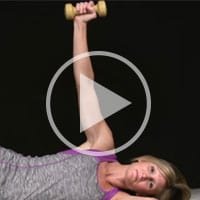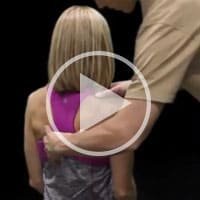5 Reasons to Consider Modified Scapular Retraction Test
The Scapular Retraction Test (SRT) is quite possibly the most critical component in my shoulder exam. It provides valuable information as to the etiology of shoulder dysfunction. Plus, the maneuver often provides instant pain reduction, and serves as a confidence booster for both you and your patient. The SRT has recently been criticized for its validity when performed in isolation—like every other orthopedic test!(1) However, when performed in conjunction with complementary tests, it can be a game changer for your shoulder exam, rehabilitation protocols, and patient education. In today's blog, you will learn simple modifications to the SRT that will provide valuable clinical information and subsequent improved adherence to care.
Why Does This Matter?
Stabilization of the scapula during overhead arm motion requires synchronization of 17 muscles. Weakness in the serratus anterior and lower trapezius are significant contributors to shoulder dysfunction, i.e., scapular dyskinesia. Uncoordinated stabilization results in potentially harmful force transfer to more distal sites in the shoulder and arm. Scapular dyskinesis may cause or perpetuate disorders of the glenohumeral joint, elbow, and wrist. The modified SRT helps clinicians and patients understand if scapular stabilization is a factor in their shoulder condition.
What is the Scapular Retraction Test?
The SRT begins with a standing patient with their affected shoulder elevated to 90° in the scapular plane and thumb pointing up. The clinician stands behind the patient and places their palm and thenar eminence on the spine of the scapula. Their forearm stabilizes the medial border of the scapula toward the inferior angle. The patient isometrically flexes their shoulder against resistance; first unassisted, then with their scapula supported by the provider. Pain levels and strength are compared during isometric contraction in both situations. (2,3) The test is considered positive with an increase in shoulder strength or a reduction in shoulder pain, implicating scapular dyskinesis as a contributor to the patient’s condition.
What is the Modified SRT?
This test is a comparison between unassisted and assisted movement. First, the patient abducts their arm in a scapular plane and notes symptoms. The patient then repeats this motion while the clinician helps with retraction and posterior tilt of the scapula (pushing the inferior angle of the scapula toward the spine). Relief of impingement symptoms and increased rotator cuff strength is a positive test, suggesting that scapular dyskinesis is contributing to the patient's rotator cuff impingement symptoms.
What’s the Difference?
1. Patient Positioning
A sitting patient is more stable in isolating the upper quadrant compared to the standing position. Provider stabilization in the traditional SRT requires superior to inferior force placed upon the scapula. There is also posterior to anterior force applied to the thorax. Patients must counteract these forces via compensatory movements or stabilization patterns—ultimately affecting the results of the test.
2. Hand Placement
In the new study, hand and forearm placement on the scapula does not induce posterior tilt as effectively as the original (ChiroUp) version. Try it with your next patient. Standing next to a seated patient and applying force with your palm allows for a more direct line of inferior and medial drive, better mimicking the action of the serratus anterior and lower trapezius.
3. Arm Movement
In the clinical setting, patients often have a specific activity or range of motion leading to their painful condition. Rarely will a patient have shoulder pain presenting only at 90 degrees of shoulder flexion in the scapular plane. While researchers must limit variability in performing tests, patient injuries rarely follow the same patterns. Tendinosis may affect different segments of the supraspinatus. Furthermore, there may be painful tissue outside of the supraspinatus unloaded in a specific shoulder position. Exploiting arcs of motion to reproduce pain is the duty of the practitioner, and may not be standardized across the board.
How Does This Affect My Treatment?
Patient Adherence to Rehab
If the SRT is positive, scapular stabilization exercises are the next step. The patient should be eager to start the process since pain is demonstrably reduced with added stability. Keep in mind, strengthening takes time. The patient should be informed that the long-term outlook is good, but their participation in care in necessary to reduce pain currently and prevent recurrance. One common scapular strengthening exercise is the Eccentric Scapular Stabilization exercise.
Patient Education
The scapulothoracic joint is unique. Modification of joint position and retesting painful movements provides real-time feedback for the patient and provider. The patient may experience instant symptomatic relief. (It is not often in MSK care that the patient can modify symptoms instantly.) If the SRT is positive, consider using the scapular repositioning test by Kibler. Scapular repositioning is an active skill utilized by patients to modify symptoms and redistribute forces during normal activities. This education empowers the patient to stabilize their shoulder during otherwise painful motions, thereby improving their prognosis.
Conclusion
Shoulder pain is undoubtedly the result of many variables specific to each patient. Individual habits, sports, hobbies, postural, or repetitive stresses all may contribute to shoulder injury. Identifying specific damage to the shoulder may be accomplished through an orthopedic exam, functional movement testing, or diagnostic imaging. But, when your traditional orthopedic exam fails to identify a diagnosis—GET CREATIVE! Don’t go home and kick the family dog, cut off all the tags on your mattresses, and mix a bowl of skittles and M&M’s. Blend evidence-based information with evidence-informed decisions to provide the best possible care to your patients.
The SRT determines if scapular dyskinesia is directly related to the symptomatic shoulder.
ChiroUp subscribers have access to the full condition protocol for Scapular Dyskinesis. Watch the 1-minute demo below for a breakdown of ChiroUp’s condition reference:
Feel like you’re missing out? You can go to our plans & pricing page to set an account up in as little as two minutes. If you have any questions about the options or would like a demo before committing, let me know. I’m here to help. You can email me at Brandon@ChiroUp.com.
-
Fernandez-Matias R, Gallardo-Zamora P, Sanchez-Aguilera CL, Mardones-Varela H, Gallego-Izquierdo T, Pecos-Martin D. Reliability of the Scapula Reposition Test in Subjects with Rotator Cuff Tendinopathy and Scapular Dyskinesis. Journal of Clinical Medicine. 2020 Jan;9(1):80 Link
Tate AR, Mcclure P, Kareha S, Irwin D. Effect of the scapula reposition test on shoulder impingement symptoms and elevation strength in overhead athletes. journal of orthopaedic & sports physical therapy. 2008 Jan;38(1):4-11. Link
Kibler WB, Sciascia A, Dome D. Evaluation of apparent and absolute supraspinatus strength in patients with shoulder injury using the scapular retraction test. The American journal of sports medicine. 2006 Oct;34(10):1643-7. Link


